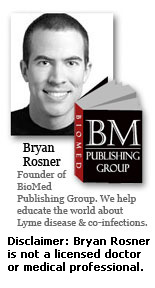Lyme Disease Tests
By Bryan Rosner on Jul 11, 2008 in Testing & Diagnosis
This post is an excerpt taken from my new book, written with Tami Duncan, called The Lyme Autism Connection, available from http://www.lymebook.com/lyme-autism-connection. The post describes many different testing methods and their pros and cons. This is by no means a complete list or complete discussion of the topic. Just some “meaty” information to get you started. 🙂
Testing for Lyme disease and Co-infections
As you know from reading this book (and will learn more about in Appendix B) Lyme disease diagnosis and treatment is highly controversial and difficult. Unfortunately, there is not a general consensus on which types of tests are most accurate and useful for diagnosing Lyme disease. Numerous tests are available, each of which uses different methodology for detecting Borrelia and related co-infections.
What is agreed on, however, is that most Lyme disease tests can produce false-negative test results (meaning that the test indicates no presence of the Lyme infection when, in fact, it is present). For this reason, regardless of which test(s) you choose, it is critical to keep in mind that a negative result does not mean that Lyme disease is not present!
Robert Bransfield, MD, (www.mentalhealthandillness.com) offers 27 reasons why Lyme disease tests produce false-negative results:
1. Recent infection before immune response
2. Antibodies are in immune complexes
3. Spirochete encapsulated by host tissue (i.e.: lymphocytic cell walls)
4. Spirochete is deep in host tissue (i.e.: fibroblasts, neurons, etc.)
5. Blebs in body fluid, no whole organisms needed for PCR
6. No spirochetes in body fluid on day of test
7. Genetic heterogeneity (300 strains, 100 in U.S.)
8. Antigenic variability
9. Surface antigens change with temperature
10. Utilization of host protease instead of microbial protease
11. Spirochete in dormancy phase (L-form) with no cell walls
12. Recent antibiotic treatment
13. Recent anti-inflammatory treatment
14. Concomitant infection with Babesia may cause immunosuppression
15. Other causes of immunosuppression
16. Lab with poor technical capability for Lyme disease
17. Lab tests not standardized for late stage disease
18. Lab tests labeled “for investigational use only”
19. CDC criteria is epidemiological, not a diagnostic criteria
20. Lack of standardized control
21. Most controls use only a few strains as reference point
22. Few organisms are sometimes present
23. Encapsulated by glycoprotein “S-layer” which impairs immune recognition
24. “S”- layer binds to IgM
25. Immune deficiency
26. Possible down regulation of immune system by cytokines
27. Revised W.B. criteria fails to include most significant antigens
In the event that a negative test result is received, there are other methods by which the presence of Lyme disease can be confirmed. One such method is known as a “therapeutic trial,” in which a person who is suspected of having Lyme disease undergoes a trial period of Lyme disease therapy for the purpose of determining whether or not the therapy leads to clinical improvement. If clinical improvement or herxheimer reactions result, there is a high probability that, despite negative test results, Lyme disease is actually present.
Another method for confirming or denying the presence of Lyme disease after a negative test result is to simply use a different testing method. The following section includes general information about the available testing methodology. The Lyme Induced Autism (LIA) Foundation provided significant contribution to this section via their handout entitled Testing for Lyme/Borrelia and Multiple-Infections.
In addition to testing for Lyme disease and co-infections, it is also helpful to identify which heavy metals, if any, are present. See Appendix C for more information on testing for and treating heavy metal toxicity.
Testing Guidelines for Infections and Parasites
Testing for Lyme disease, Borreliosis and multiple-infections can be difficult to understand. We hope that this guide will help to narrow down the lab testing and options available. One thing to keep in mind is that many times the lab testing that our insurance generally pays for is not necessarily the most appropriate or accurate available. To avoid needless blood draws, wasted time and resources, we recommend getting the appropriate testing done first so that parents can have a clear picture of their child’s infection load prior to starting therapy interventions.
Testing for Lyme disease (Borrelia burgdorferi), Babesia, Anaplasma, Ehrlichia and Bartonella
Testing for Lyme disease/Borrelia and other infections is not a simple task. A person with a compromised immune system may not make the necessary antibodies needed to generate an accurate reading. No test is perfect and someone may have the organism(s) in their body and still have a negative test result. A positive antibody test shows evidence of the body’s response to an organism, not the organism itself.
There may also be multiple strains of an organism, yet we typically can only test for one, such as Bartonella, which has nine pathogenic strains but antibody tests only exist for one or two. Therefore, testing should be viewed as helpful information that must be considered within the context of the patient’s history and physical findings—testing should not be considered 100% accurate for a final diagnosis.
The “lyme titer” or “ELISA” test that is often first ordered as a “screen” by some clinicians can be very inaccurate. The Lyme/Borrelia “Western Blot” is a more sensitive test. Standard laboratories do not test for all of the “bands” in the Western Blot that are specific to Lyme/Borrelia. Many people will get a false negative from the commercial labs or from a doctor who is not trained to interpret tests properly. It is important to note that if the test comes back negative, the results may be inaccurate.
Testing Laboratories
Although the LIA Foundation does not recommend a specific lab, the following is a list of labs which we believe offer a superior quality of test compared to the standard lab.
IGeneX
This lab has a variety of panels and individual tests available. Most Lyme literate practitioners will order the Western Blot IgG / IgM for Borrelia (#188, #189). This Western Blot is the only one that tests for every Borrelia-specific band. They may also choose to order the PCR or IFA as well. IGeneX also offers testing for Babesia, Ehrlichia, Anaplasma and Bartonella (in addition to antibody tests for these infections, you should also strongly consider the “FISH” test [discussed below], which is a direct fluorescent staining of the organism). IGeneX offers a “complete co-infection panel”(#5090) and also a “western regional complete co-infection panel” (#5080). A PCR test is best done during a symptom “flare” or during menses, if applicable. IGeneX recommends having at least two Borrelia specific bands, in addition to associated symptoms, to make a positive diagnosis.
Phone: (800) 832-3200
Website: www.igenex.com
NeuroScience/NeuroImmunology Labs
This lab has 3 panels which include the standard Western Blot, antibody testing, and testing for many of the co-infections such as Babesia, Ehrlichia and Bartonella. Not all specific bands are checked on the Western Blot, only those in the CDC “panels.” In addition, this lab does specialty testing for Autism Spectrum Disorder.
Phone: (715) 294-2852 – Email: info@neuroimmunologylabs.com
Central Florida Research
Central Florida Research
342 E. Central Ave.
Winter Haven, Florida 33830
CFR is open Monday – Friday from 8 a.m. – 5 p.m. EST (GMT -5:00)
Phone Number: (863) 299-3232
Fax Number: (863) 299-3355
Medical Director: Clifford H. Threlkeld, DO, FCAP
Florida State License Number: 800021816
CLIA Certificate #: 10D1059481
Website: www.centralfloridaresearch.com
Fry Clinical Labs
This lab does direct visual microscopy of a blood sample and thus can identify Babesia, Bartonella and others even when antibodies are not present or at very low levels. A positive visual identification of the pathogen(s) may be definitive; however, a result indicating that “no organisms were seen” does not necessarily rule out the possibility that the organisms are present but missed during the test. Some organisms, especially Lyme/Borrelia, are often difficult to detect due to their elusive presence in deep tissue which are not examined or visible during blood tests.
Phone: (480) 991-4555
Testing for Mycoplasma
According to research done by the Institute for Molecular Medicine and reported on their website at www.immed.org, “we have identified systemic infections, such as those produced by Mycoplasma species, Chlamydia pneumoniae and Human Herpes Virus-6 (HHV-6), in a high percentage of Autism Spectrum Disorder (ASD) patients, and these infections are likely to be important in determining the treatment strategies for many ASD patients.”
Medical Diagnostic Laboratories (MDL)
Professor Garth Nicolson’s work from the Institute for Molecular Medicine found that 58% of ASD children have multiple strains of Mycoplasma. This lab offers the “Mycoplasma General PCR test” and “Mycoplasma Fermentans PCR test.” Also, HHV-6 (human herpes virus-6), can be tested here; both antibody and PCR.
Phone: (877) 269-0090
Website: www.mdlab.com
Testing for Viruses
It is a good idea to test for HHV-6 as many children have a significant viral load. A subset of children with autism have shown improvement by using anti-viral treatments.
ViraCor Laboratories
Direct effects of HHV-6 include fever, rash, hepatitis, encephalitis, pneumonitis and delay or suppression of bone marrow engraftment. This lab tests for HHV-6 by the PCR method.
Phone: (800) 305-5198
Website: www.viracor.com
Parasites, Yeast and Gastrointestinal Testing
The bodies of children and adults suffering from chronic illnesses are typically ideal environments for parasites and yeast. It is important to discover which microbes are causing trouble. Below is a list of labs which are commonly used for this type of testing.
Diagnos-Techs, Inc.
The “GI Health” and “Expanded GI Health” panels test for several types of parasites, food intolerances, gut function and general GI health.
Phone: (800) 878-3787
Website: www.diagnostechs.com
Genova Diagnostics
This lab offers several panels, including the “Parasitology profile” or, for a more detailed panel, the “Comprehensive Stool Analysis.”
Phone: (800) 522-4762
Website: www.gdx.net
Great Plains Laboratory
Many physicians have confidence in this lab due to their specialized testing. For Candida testing, an “Organic Acid Test” or “Microbial OAT Panel” can give a clear picture as to the yeast or bacterial overgrowth in the patient.
Phone: (800) 288-0383
Website: www.greatplainslaboratory.com
Metametrix Clinical Laboratory
This laboratory can be used for stool cultures, organic acids, and metabolites of bacteria and pathogenic yeast. They also offer tests for fatty acids, metabolism, Krebs cycle issues, and functional vitamin deficiencies.
Phone: (800) 221-4640
Website: www.metametrix.com
Doctors Data
Doctors Data offers comprehensive stool analysis, parasitology, and microbiology panels which help to investigate the health of the GI tract. In addition, this lab is great for heavy metal toxicity testing.
Phone: (800) 323-2784
Website: www.doctorsdata.com
Heavy Metal Testing
It is well known that autism can be associated with heavy metal poisoning, by elements such as arsenic, copper, mercury, and others. For this reason, heavy metal testing should be conducted. The labs most often relied on are Great Plains Laboratory and Doctors Data. See Appendix C for more information. Since heavy metals are not always found in the blood and many prefer tissue, bone or other locations, this is a useful screen test. At times, it requires some expertise to read the results since some minerals can be high or low and either can be a flag for further follow up.
According to Dr. James Schaller, MD:
Based on my research, all Americans have levels of some toxic heavy metals which undermine optimal health. This research was based on using a wide variety of respected chelation challenge agents, and doing pre- and post- testing which fit each agent’s mechanism. All patients were found to have heavy metal ranges that would undermine health.
If this is true, why allow autistic or Lyme infected children to have this additional burden on neurologic and immune function to exist? There are many child-friendly chelation agents available at this time. So talk to an expert in chelation and read widely.
Some health care professionals might be too frozen into using a limited number of options, and may not be familiar with the full range of non-IV options presently available.








